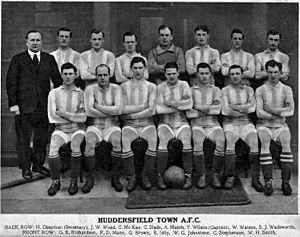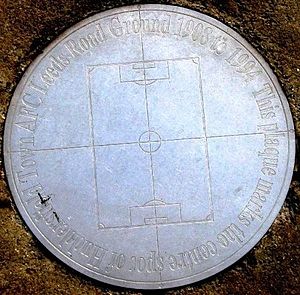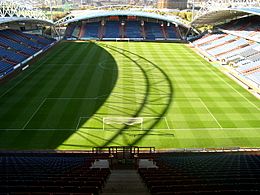Huddersfield Town A.F.C. facts for kids
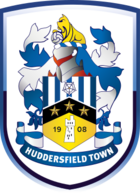 |
||
| Full name | Huddersfield Town Association Football Club | |
|---|---|---|
| Nickname(s) | The Terriers | |
| Founded | 15 August 1908 | |
| Ground | Accu Stadium | |
| Capacity | 24,121 | |
| Owner | Kevin M. Nagle | |
| Chairman | Kevin M. Nagle | |
| Manager | Lee Grant | |
| League | Championship | |
| 2018–19 | Premier League, 20th of 20 (relegated) | |
|
|
||
Huddersfield Town Association Football Club is a professional association football team from Huddersfield, West Yorkshire, England. They play in Championship, which is the third level of English football.
The club started on August 15, 1908. They first played in the North Eastern League and Midland League. In 1910, they joined the Football League. They moved up from the Second Division in 1919–20. Then, they won the FA Cup in 1922, after being finalists in 1920.
Under manager Herbert Chapman, Huddersfield won the league championship three times in a row: 1923–24, 1924–25, and 1925–26. They also reached three more FA Cup finals but lost them: 1928, 1930, and 1938. After 32 years, they were moved down from the First Division in 1952. However, they quickly moved back up the next season. They were moved down again in 1956.
Huddersfield won the Second Division title at the end of the 1969–70 season. But then, they were moved down three times in four years by 1975. They won the Fourth Division in 1979–80. They also moved up from the Third Division in 1982–83. After being moved down in 1988, they lost in the 1994 final of the Football League Trophy.
However, they returned to Wembley the next year. They won the third level's play-off final. In 2003, they went back to the fourth level after being moved down twice in three years. Huddersfield reached the Premier League by winning three play-off games. These wins were from Division Three in 2004, from League One in 2012, and from the Championship in 2017. They played in the Premier League for two seasons before being moved down in 2019. They were moved down from the Championship in 2024.
The team has played home games at the Kirklees Stadium since 1994. This stadium is now called the Accu Stadium because of sponsorship. The club's blue and white striped colours were chosen in 1913. Their nickname, "The Terriers", was adopted in 1969. Huddersfield's current team emblem is based on the town's coat of arms. The team has long-standing rivalries with Bradford City and Leeds United. These are known as West Yorkshire derbies.
Contents
Club History: Key Moments
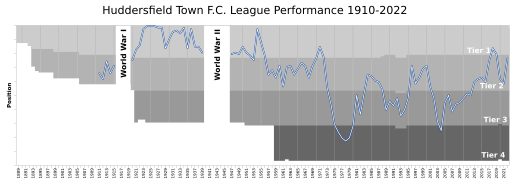
Starting Out and Golden Years (1908–1945)
The club began in 1908. The founders bought land at Leeds Road for £500. They joined the North Eastern League. The next season, they joined the Midland Football League to save money on travel. To join the Football League, the club asked Scottish architect Archibald Leitch to rebuild Leeds Road. A new stand with 4,000 seats was planned, along with other areas for fans, making the total capacity 34,000.
After these plans, Huddersfield was accepted into the Football League in 1910. Building work at Leeds Road started right away. However, the costs were too high, and fewer than 7,000 people came to games. Huddersfield went bankrupt in 1912. A new company was then created to take over the club.
In 1919, Huddersfield Town was reportedly £25,000 in debt. Only about 3,000 fans came to games. The chairman, John Hilton Crowther, wanted to combine Town with the new team Leeds United and move the club to Leeds. This news made supporters start raising money to stop the move. They sold £1 shares, making the club owned by the public. After a month of fundraising and talks, the club stayed in Huddersfield. The team then reached the 1920 FA Cup final and won promotion to the First Division for the first time.
In their first season in the top league, Herbert Chapman became the new assistant manager. Chapman took over as manager in March 1921. He led the team to finish 17th. In the summer of 1921, the team gained key players like playmaker Clem Stephenson and the club's top goal scorer, George Brown. Chapman's plan was to have a strong defence and quick counter-attacks. He focused on fast, short passes and clever runs from his wingers. He is seen as the first manager to use the counter-attack successfully. He also made players follow a strict fitness plan. He made sure the reserve and youth teams played the same way as the main team. He had a wide network of scouts to find the right players.
The team won their first big trophy, the FA Cup, in 1922. They beat Preston North End 1–0 in the 1922 FA Cup final. Huddersfield also won the 1922 Charity Shield, beating Liverpool 1–0. Town finished third in 1922–23. Then, they won their first First Division championship in 1923–24. They beat Cardiff City by a very small difference in goal average. Huddersfield won 3–0 against Nottingham Forest in their last match. Cardiff drew 0–0 and missed a penalty.
The team won the First Division title again in 1924–25. They lost only one of their last 27 league matches. Huddersfield let in only 28 goals and never more than two per game. This was the first time a team had done this. In October 1924, Billy Smith made history by scoring directly from a corner. After winning two league titles, Chapman left for Arsenal. Arsenal offered him more money and had bigger crowds. Cecil Potter took over as manager. Under Potter, Town became the first club to win three English League titles in a row in 1925–26. The team almost won a fourth title the next season. But they won only one of their last seven matches, giving the title to Newcastle United. Town finished second in both the league and the FA Cup final in the 1927–28 season.
In March 1928, five Town players played in an international match between England and Scotland. Tom Wilson, Bob Kelly, Billy Smith, and Roy Goodall played for England. Alex Jackson played for Scotland. Jackson scored three goals as Scotland, known as "The Wembley Wizards", beat England 5–1.
Huddersfield's older players were not replaced well. Their league position got worse. However, they finished second in 1933–34. They also reached two more FA Cup Finals under new manager Clem Stephenson. Town lost in 1930 to Chapman's Arsenal. They lost in 1938 to Preston North End after extra time. This was the first FA Cup final shown on television. A record number of 67,037 fans came to a home game in 1932. This was an FA Cup match against Arsenal.
Challenges and Comebacks (1945–1992)
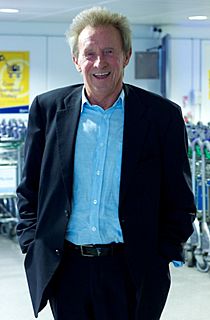
Town was moved down for the first time in the 1951–52 season. Stockport County manager Andy Beattie was hired in April 1952. He managed both Stockport and Huddersfield in three different leagues in the same month. The team finished second in the Second Division in 1952–53 and quickly returned to the top league. They finished third in their first season back. After Town was moved down in 1955–56, Beattie left as manager in November 1956. Bill Shankly took his place. In December 1957, the team was leading 5–1 with 30 minutes left against Charlton Athletic, but they lost 7–6. Shankly left in December 1959 to manage Liverpool.
Floodlights were put in at Leeds Road in 1961. These were paid for by the record transfer fee of £55,000 for Denis Law to Manchester City. The lights became known as the "Denis Law Lights".
Huddersfield continued to play in the second level during the 1960s. They reached the semi-final of the League Cup in 1967–68, but lost to Arsenal. In 1969, the club started using the nickname "The Terriers". Town won the Second Division in 1969–70 with Ian Greaves as manager. The team stayed in the first level for their first season back. But they were moved down in 1971–72. This was followed by another move down to the Third Division for the first time the next season. Huddersfield was moved down to the Fourth Division for the first time in 1974–75. In the 1974–75 season, Lloyd Maitland became the first black player to play for Huddersfield Town on February 8, 1974.
A comeback began under manager Mick Buxton, who was hired in 1978. Huddersfield won the Fourth Division in 1979–80, scoring 101 goals. Town just missed out on promotion the next season. The team won promotion to the Second Division in 1982–83 by finishing third. Because Huddersfield was at the bottom of the league and fewer fans were coming, Buxton was fired in December 1986. Steve Smith took over. He was the first (and only, as of 2025) permanent manager from Huddersfield. The team stayed up by three points that season. But they were moved back to the third level in 1987–88. Town won only six matches, let in 100 goals, and lost 10–1 against Manchester City. Huddersfield reached the 1991–92 Third Division play-offs. But they lost the semi-final against Peterborough United 4–3.
New Home and Premier League Dreams (1992–2019)
The team avoided being moved down to the Third Division (which was renamed from the Fourth Division after the Premier League started) in 1992–93. They had only three losses in their last 17 league games, finishing 15th. Manager Neil Warnock took over for the 1993–94 season. Town reached the 1994 Football League Trophy final, but lost to Swansea City on penalties.
Huddersfield Town played their last game at Leeds Road on April 30, 1994. They beat Blackpool 2–1, with almost 16,195 fans watching. They moved into the new Kirklees Stadium (then called the Alfred McAlpine Stadium) for the 1994–95 season. In their first season at the new stadium, Huddersfield moved up to the second level. They won the play-offs with a 2–1 win against Bristol Rovers at Wembley. Warnock left that summer. Brian Horton replaced him and led Town to an eighth-place finish the next season.
Horton was fired in October 1997. Huddersfield had not won any of their first nine games. Former Huddersfield player Peter Jackson got the job. They earned only one point in Jackson's first five games. But Huddersfield finally won their 15th match, beating Stoke City 3–1. They had some good runs and some bad runs, but Town managed to stay up, finishing 16th.
In January 1999, local businessman Barry Rubery bought the club. He aimed to reach the Premier League. Steve Bruce took over from Jackson in May 1999. Huddersfield was at the top of the league in December. But their performance dropped after striker Marcus Stewart was sold in January to Ipswich Town. They finished the season in eighth place, just outside the play-offs. Bruce was fired in October 2000. Rubery said Bruce "wasted £3 million". Lou Macari replaced him. He could not stop the team from being moved down to the third level at the end of the season. Huddersfield reached the play-offs in 2001–02, but lost 2–1 to Brentford in the semi-final.
Around this time, the club had debts of £20 million. This was after being moved down and the failure of ITV Digital. Players went months without being paid. Manager Mick Wadsworth was fired in January 2003, but then brought back because the club had no money to pay him off. Wadsworth was finally fired in March. Mel Machin replaced him. He saw the team moved down to the fourth level. The club went into administration. But Ken Davy bought the club in the summer of 2003 and saved Town from closing down. Manager Peter Jackson had only four main players before the 2003–04 season. Many young players from the academy joined the team. Huddersfield finished in a surprising fourth place. They beat Mansfield Town in the play-off final to return to the third level.
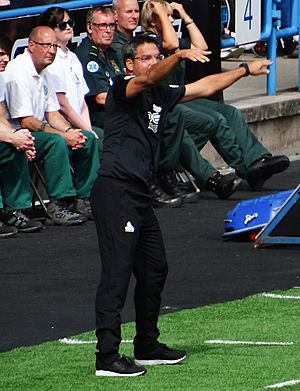
The team reached the play-offs in 2005–06, but Barnsley beat them in the semi-final. Dean Hoyle became chairman and main shareholder in June 2009. Town reached the play-offs in 2009–10 under manager Lee Clark. But they lost to Millwall in the semi-final. The team qualified for the play-offs again the next season. However, Peterborough United won the final. Huddersfield set a Football League record of 43 matches without a loss (not including play-off games) in November 2011. This record was previously held by Nottingham Forest. Clark was fired in February 2012 after a 1–0 home loss to Sheffield United. Former Leeds United manager Simon Grayson replaced him. He led Town to the play-off final against Sheffield United. The game was 0–0 after extra time. Huddersfield won after 22 penalties (8–7).
Despite this success, Grayson was fired in January 2013. Mark Robins took over. Huddersfield avoided being moved down on the last day, after a draw with Barnsley. German Borussia Dortmund II coach David Wagner became the first manager born outside the British Isles in November 2015. He used the "Gegenpressing" style of play. In 2016–17, Town finished fifth and qualified for the play-offs. They beat Sheffield Wednesday on penalties in the semi-final. Then they played Reading in the final. Another penalty shoot-out happened, and Huddersfield won again. Moving up to the Premier League meant returning to the top level for the first time since 1972. Huddersfield also became the second club, after Blackpool, to have won all three divisional play-offs.
The team finished 16th in the Premier League in the 2017–18 season and stayed up. But they were moved down after finishing 20th in 2018–19. Wagner left the club in January 2019. Jan Siewert from Borussia Dortmund II replaced him. But Town was moved down in March with six matches left. The team won only three games and had 16 points by the end of the season.
Recent Years and New Owners (2019–Present)
Chairman Hoyle announced he was leaving in May 2019. He sold the club to businessman Phil Hodgkinson due to health reasons. Siewert was replaced by Lincoln City manager Danny Cowley in September 2019. Cowley helped the club stay in the Championship before he was fired. Leeds United assistant coach Carlos Corberán became the club's new head coach in July 2020.
Huddersfield finished third in the EFL Championship. They played fourth-placed Nottingham Forest in the 2022 EFL Championship play-off final at Wembley, losing 1–0. Town felt they should have had two penalty kicks.
Corberán left in July 2022, just before the 2022–23 Championship season. He joined Olympiacos in Greece. Former Town player Danny Schofield became the new head coach. But he was fired 10 weeks later after a bad start. Hertha BSC assistant coach Mark Fotheringham replaced him. He lasted only four months and was fired on February 8, 2023. Neil Warnock returned five days later. His return to the John Smiths stadium saw a 2–1 win against Birmingham on February 18, 2023. He said he had 'tears in his eyes' because of how the fans welcomed him.
On March 23, 2023, Huddersfield announced that a North American group would take over the club. Dean Hoyle, who had returned to the club in 2020, bought all the shares and then sold them. The deal was completed in June 2023. The new owner was El Dorado Hills, California (United States) investor Kevin M. Nagle, who also owns USL Championship team Sacramento Republic. Hoyle wrote off £40 million of debt to keep the club out of administration.
A 1–0 home win against Sheffield United on May 4, 2023, confirmed Huddersfield's safety. However, Huddersfield continued to struggle in the 2023–24 season. They parted ways with Warnock in September 2023. Then they hired Darren Moore as manager. But he was fired in January 2024 after only three wins in 23 matches. The club was 21st in the second level, three points above the relegation places. Moore was replaced by Andre Breitenreiter on February 15, 2024. The club finished the season in 23rd place, which meant they were moved down to League One. Breitenreiter left the club, and Michael Duff replaced him.
Team Badge and Colours
The club spent years deciding on the colour of their kit. In 1913, they chose the blue and white striped jersey that they still use today.
The club badge is based on the coat of arms of Huddersfield town. Town first used a badge on their shirts for the 1920 FA Cup Final. It was based on the town's coat of arms. It appeared again with a Yorkshire Rose for the 1922 FA Cup Final and for the finals in 1928, 1930, and 1938. The club's main colours, blue and white, are seen throughout the badge in stripes. Two Yorkshire Roses and Castle Hill are part of the club's and area's history.
Town kept the same main design (blue and white stripes) until 1966. Then, Scottish manager Tom Johnston introduced all-blue shirts. A new badge was also adopted that year. It had the letters "HTFC" on the all-blue shirts. When the club adopted the nickname "The Terriers" for the 1969–70 season, the blue and white stripes returned. A red terrier with the words "The Terriers" was also added.
After being moved down to the Fourth Division, Huddersfield returned to all-blue shirts and the "HTFC" badge when Tom Johnston came back in 1975. Stripes returned in the 1977–78 season and have been the club's home kit ever since. In 1980, Town adopted the badge they still use today. It combined parts of the old town coat of arms with new designs, like blue and white stripes and a terrier with a football.
In 2000, Huddersfield changed its badge to a round design. But fans did not like it, so they soon returned to the older, shield-like badge. The badge was changed slightly again in 2005. The club decided to remove "A.F.C." from the text, leaving only "Huddersfield Town". This made it easier to put on shirts and other club items.
The club adopted a Terriers logo in 2018. It was used only on the kit and did not replace the main badge. In 2019, Town agreed to a shirt sponsorship with Paddy Power. The shirt had a diagonal sash design. Soon after, the club was contacted by The Football Association about the kit. It was later revealed that the shirt was a prank by Paddy Power. The club then played in shirts without a sponsor as part of their "Save Our Shirt" campaign.
Huddersfield returned to an updated version of their shield-like badge in 2019. The three stars (which stand for their three league titles in the 1920s) were moved inside the shield. Also, a single Yorkshire Rose was placed at the top of the blue and white stripes, above the three stars. The shield was also made more modern. The Terrier was put into the badge at the top of the shield. The club's founding date was added on either side of Castle Hill.
Kit Suppliers and Shirt Sponsors
| Period | Kit manufacturer | Shirt sponsor (chest) | Shirt sponsor (sleeve) |
|---|---|---|---|
| 1975–1979 | Bukta | None | None |
| 1979–1982 | Barralan | ||
| 1982–1984 | Bukta | Central Mirfield | |
| 1984–1986 | Daihatsu | ||
| 1986–1987 | Eagle | Greenall's | |
| 1987–1990 | Matchwinner | ||
| 1990–1991 | Beaver | ||
| 1991–1993 | Gola | Gola | |
| 1993–1994 | Super League | Pulse (home) Vileda (away) |
|
| 1994–1995 | Pulse | ||
| 1995–1997 | Panasonic | ||
| 1997–1999 | Pony | ||
| 1999–2001 | Mitre | ||
| 2001–2002 | Bloggs | Prime Time Recruitment | |
| 2002–2003 | VOI | ||
| 2003–2005 | Admiral | ||
| 2005–2007 | Yorkshire Building Society | ||
| 2007–2009 | Mitre | CasinoRed | |
| 2009–2010 | Yorkshire Air Ambulance (home) Radian B (away) |
||
| 2010–2011 | Kirklees College (home) Radian B (away) |
||
| 2011–2012 | Umbro | ||
| 2012–2013 | Rekorderlig (home) Radian B (away) |
||
| 2013–2015 | Puma | Rekorderlig (home) Radian B (away) Covonia (third) |
|
| 2015–2017 | PURE Legal Limited (home) Radian B (away) Covonia (third) |
||
| 2017–2018 | OPE Sports | PURE Legal Limited | |
| 2018–2019 | Umbro | Leisu Sports | |
| 2019–2020 | Paddy Power (unbranded) | None | |
| 2020–2021 | Various local companies/charities |
||
| 2021–present | Utilita | Jetcoin (FA Cup only) |
Home Stadiums
- Leeds Road (1908–1994)
- Kirklees Stadium (1994–present)
- Called "Alfred McAlpine Stadium" (1994–2004)
- Called "Galpharm Stadium" (2004–2012)
- Called "John Smith's Stadium" (2012–present)
Huddersfield was the first team to have played at all four professional levels of English football at two different stadiums.
Fans and Rivalries
There's a team that is dear to its followers,
Their colours are bright blue and white,
They're a team of renown, the pride of the town,
And the game of football is their delight.
All the while, upon the field of play,
Thousands loudly cheer them on their way.
Often you can hear them say, who can beat the Town today?
Then the bells will ring so merrily,
Every goal, shall be a memory,
So Town play up, and bring the Cup,
Back to Huddersfield!
We're Yorkshire! We're Yorkshire! We're Yorkshire!
Since 1920, Huddersfield's club song has been "Smile A While". G. W. Chappell of Longwood, Huddersfield created the song before the 1920 FA Cup Final. It was based on the popular First World War song "Till We Meet Again". Chappell's song was first called "The Town Anthem". Town supporters still sing it at home matches.
In 2014, a group of Town fans started "North Stand Loyal". Their goal was to "improve the atmosphere around the stadium on matchdays". They were inspired by fan groups in Europe. In 2017, the group changed its name to "Cowshed Loyal". This group is in the South Stand, which is shared with visiting fans.
The club also has fan groups in other countries. These include Australia, Canada, Northern Ireland, Norway, Republic of Ireland, Singapore, Slovakia, and the United States. Famous fans have included Prime Minister Harold Wilson, who was born in Huddersfield. Actor Sir Patrick Stewart became president of the Huddersfield Town Academy in 2010.
Huddersfield Town's main rivals are other clubs from West Yorkshire: Bradford City and Leeds United. Town has won more games against City. They have won 21 matches, drawn 17, and lost 14. Including games against United's older team Leeds City, Huddersfield has won 36 of the 90 derby games. There have been 20 draws, and Leeds has won 34.
There are smaller rivalries with South Yorkshire clubs Barnsley and Sheffield Wednesday. There is also a Roses rivalry with Oldham Athletic. Huddersfield also has a rivalry with Cambridgeshire club Peterborough United. This is mainly because of their play-off matches in 1992 and 2011.
Players
First-Team Squad
|
|
Players Out on Loan
|
Huddersfield Town B Team
|
|
B Team Players Out on Loan
|
|
Famous Former Players
English Football Hall of Fame Members
Some former players and managers from Huddersfield Town are in the English Football Hall of Fame. This Hall of Fame started in 2002 to celebrate people who have made a great impact on the game. To be chosen, players or managers must be 30 or older and have played or managed for at least five years in England.
 Herbert Chapman
Herbert Chapman Peter Doherty
Peter Doherty Denis Law
Denis Law Bill Shankly
Bill Shankly Clem Stephenson
Clem Stephenson Ray Wilson
Ray Wilson
Football League 100 Legends
The Football League 100 Legends is a list of "100 legendary football players". The Football League created it in 1998 to celebrate 100 seasons of league football. Three former Huddersfield players are on this list.
 Clem Stephenson
Clem Stephenson Peter Doherty
Peter Doherty Denis Law
Denis Law
Player of the Year (Hargreaves Memorial Trophy)
- This award is voted for by members of the official Huddersfield Town Supporters Club.
|
|
Club Management and Staff
Club Officials
| Position | Name |
|---|---|
| Chairman | Kevin Nagle |
| Director | Michael Thomas |
| Chief Executive | Jake Edwards |
| Chief Operating Officer | David Threfall-Sykes |
First Team Technical Staff
| Position | Name |
|---|---|
| Manager | Lee Grant |
| Assistant Coaches | Paul McShane
Marc Bridge-Wilkinson Jonathan Robinson |
| Goalkeeping coach | Neil Bennett |
| Loans manager | David Fox |
| Head of Analysis & Innovation | James Beck |
| Lead First Team Analyst | Mackenzie Longley |
| First Team Analyst | Lewis Dunwoody |
| Goalkeeping Performance Analyst | Adam O'Rourke |
| Senior Physiotherapists | Liam Kershaw Craig Sedgwick Vikki Stevens |
| Sports Therapists | Matty Greenlees Matthew Potts |
| Head of Strength & IDP | Callum Adams |
| Senior Physical Performance Coach | Dan Hughes |
| Physical Performance Coach | Jordan Foster |
| Head of academy | Jon Worthington |
Managerial History
Club Achievements
In 1926, Huddersfield Town became the first English team to win the First Division title three seasons in a row. This was a huge achievement! Only Manchester City has done it more recently (in 2024), and other teams like Arsenal, Liverpool, and Manchester United have also equaled it.
Huddersfield Town was the second team, after Blackpool, to win all three divisional play-offs. They did this when they won the 2017 Championship play-off.
The club's main achievements include:
League Titles
- First Division (top level)
- Champions: 1923–24, 1924–25, 1925–26
- Runners-up: 1926–27, 1927–28, 1933–34
- Second Division / Championship (level 2)
- Champions: 1969–70
- Promoted (2nd place): 1919–20, 1952–53
- Play-off winners: 2017
- Third Division / Second Division / League One (level 3)
- Promoted (3rd place): 1982–83
- Play-off winners: 1995, 2012
- Fourth Division / Third Division (level 4)
- Champions: 1979–80
- Play-off winners: 2004
Cup Wins
- FA Cup
- Winners: 1921–22
- Runners-up: 1919–20, 1927–28, 1929–30, 1937–38
- FA Charity Shield
- Winners: 1922
- Football League Trophy
- Runners-up: 1993–94
See also
 In Spanish: Huddersfield Town Association Football Club para niños
In Spanish: Huddersfield Town Association Football Club para niños


